Im Gi Jeon1
I Introduction
In Korea, marine finfish culture was first attempted in 1964 in a
pilot-scale floating net-cage culture on the southeastern coast of Korea.
Since then, marine finfish culture has developed gradually in the southern
coast where suitable sites for floating netcages can be found easily on
account of many islands. In the early stage, floating netcage culture
consisted merely of rearing temporarily natural fry collected by fishermen.
After 1976, although the demand for the high-valued fishes rapidly
increased, possibly related to the increment of the population and the
positive development of the national economy, the annual amount of catch in
the adjacent sea of Korea remained stagnant at a level of 1,200,000 MT,
owing to over-exploitation with the use of mechanized fishing gear.
Conversion of the traditional fisheries to the aquaculture is being
demanded and realized if more high-valued finfish are to be produced.
The finfish culture production in ROK in 1987 was 1,773 MT (Table 1 and 2).
This amount is 0.1 percent of the annual amount of finfish catch. Major
reasons why the finfish production from aquaculture activities remains low
in spite of the high demand, are the lack of suitable sites and feed.
Floating netcages are fragile against strong winds and waves, therefore
they should be installed in areas sheltered from strong sea action. The
fish farming sites are increasing year by year (Table 3), but most of the
potential sites for floating netcages are already being utilized for
shellfish and seaweed culture. The finfish farm sites in 1987 occupied
only 0.3 percentage of total aquaculture sites. For this reason Korean
fish farmers and researchers are trying to develop new finfish culture
method, like land mariculture system and mid-water or sea bed netcage
culture.
Table 1. Production of major mariculture resources (Unit: MT)
| Year | Total | Fishes | Crustaceans | Shellfish | Seaweeds | Others |
| 1980 | 540,546 | 38 | 86 | 282,560 | 257,880 | - |
| 1981 | 701,065 | 31 | 117 | 317,779 | 383,063 | 55 |
| 1982 | 596,316 | - | 109 | 280,966 | 314,535 | 706 |
| 1983 | 643,789 | - | 50 | 289,368 | 347,227 | 7,153 |
| 1984 | 678,321 | 331 | 83 | 282,588 | 383,661 | 11,648 |
| 1985 | 787,571 | 1,413 | 87 | 369,035 | 397,461 | 19,575 |
| 1986 | 946,965 | 2,915 | 133 | 398,994 | 524,127 | 20,796 |
| 1987 | 866,063 | 1,773 | 201 | 446,852 | 398,100 | 19,137 |
1 National Fisheries Research and Development Agency, Pusan, Republic of Korea
Table 2. Production of finfishes cultured
(Unit: MT)
| Year | Total | Yellowtail | Red sea bream | Rock fish | Seabass | Flat fish | Others |
| 1980 | 38 | 7 | - | - | - | - | 31 |
| 1981 | 31 | 6 | - | - | - | - | 25 |
| 1982 | - | - | - | - | - | - | - |
| 1983 | - | - | - | - | - | - | - |
| 1984 | 331 | 323 | - | - | - | - | 8 |
| 1985 | 1,413 | 1,351 | - | - | - | - | 62 |
| 1986 | 2,915 | 2,910 | - | - | - | - | 5 |
| 1987 | 1,773 | 1,418 | 106 | 85 | 70 | 20 | 74 |
Table 3. Annual variation of the finfish culture sites and production
| Year | 1982 | 1983 | 1984 | 1985 | 1986 | 1987 |
| Total sites (ha) | 159 | 158 | 225 | 217 | 336 | 475 |
| Netcages (ha) | 159 | 117 | 182 | 165 | 263 | 262 |
| Enclosures (ha) | - | 41 | 41 | 48 | 68 | 184 |
| Land mariculture (ha) | - | - | 2 | 4 | 5 | 29 |
| Production (MT) | 81 | 1,050 | 1,501 | 1,413 | 2,915 | 1,773 |
II. Environmental characteristics of Korean coast
The Korean peninsula is surrounded by the sea on three sides except for the northern part. The surrounding waters of the Korean peninsula can be divided into three regions by their environmental characteristics : East, West and South sea.
a. Eastern coast
The Eastern coast is sharply pounded by strong wave action and has many submerged rocks and reefs. The coastal line is monotonous without any sheltered area. Therefore, it is difficult to establish a floating netcage culture system on this coast.
b. Western coast
These waters are characterized by numerous islands, rivers, indented seashores and vast tidal flats affected by big scale tidal action. Therefore, the sea water of this area contains much suspended solids and its salinity is considerably lowered during the rainy season due to the influx of inland water. In addition, the difference between high and low water is too big to practically manage floating netcages.
c. Southern coast
The waters in this area are much shallower than in the eastern coast and characterized by moderate wave action. This area is archipelagic with many inner bays formed along the coast. The local current is strongly influenced by the Tsushima warm current, a branch current of Kuroshio (Fig. 1). Therefore, this coast is adequate to set various kinds of aquaculture facilities. Actually, most of the marine finfish culture farms are in this area (Fig. 2). In spite of these favored conditions, wintering of warm water species, like yellowtail and seabream, is not possible in most areas owing to the cold water temperature. The water temperature along the southern coast remains below 10 °C during the winter months (Fig. 3).
III. Species of Commercial Importance
There are five main species for culture as follows:
| - Yellowtail | (Seriola quinqueradiata) |
| - Red seabream | (Chrysophrus major) |
| - Rockfish | (Sebastes schlegeli) |
| - Seabass | (Lateolabrax japonicus) |
| - Flatfish | (Paralichthys olivaceus) |
Although there are five species commercially cultured, production is very low, except for yellowtail. Yellowtail, a warm-water species, grows well particularly during the summer months. This species can attain a marketable size of 400 or 600 g in 5 months from an initial stocking size of 1–10 g. The other species require 2 or 3 years before attaining the marketable size. Therefore, farmers prefer yellowtail to the other species, since they can get the money in a short term.
IV. Floating Netcage System
The floating netcage system consists of the netcage and a frame to support
the nets. The unit frame is constructed by using 12 lauan beams (12cm ×
12cm × 12 m) and several anchors (50 kg). The beams are joined by bolts
and nuts (Fig. 4A).
The minimum finfish farm site licensed per farmer is 1 ha (10,000 m ) water
space, and the farmer can use 20% of it. Therefore, one finfish farm is
generally constituted by 20 raft units, 1 working raft and 1 or 2 work
boats (Fig. 4B). The dimensions and mesh-sizes of the netcages are
dependent on the species cultured and size. Usually three different
dimensions of netcages are used: 3 × 3 × 3m, 5 × 5 × 5m and 10 × 10 × 5m
(or 10m). Recently some experiments have been carried out with mid-water
floating netcage culture to evaluate the feasibility of finfish netcage
culture in rough waters (Fig. 5).
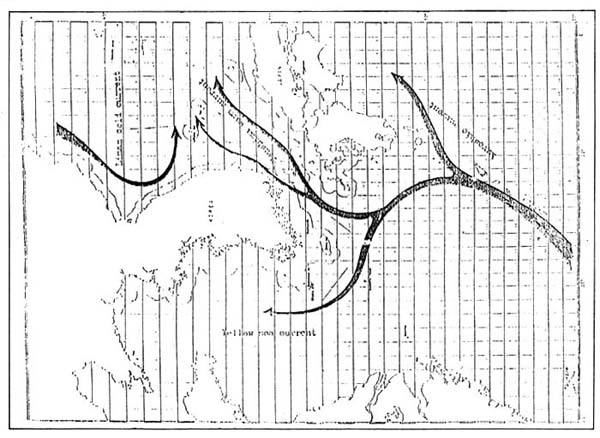
Figure 1. Major currents influencing the water movements along the coast of the Korean peninsula.
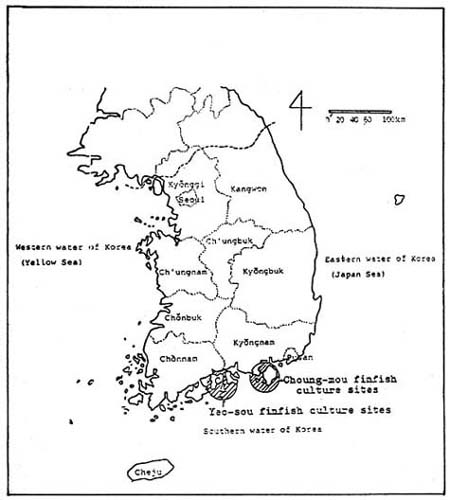
Figure 2. Major finfish culture sites.
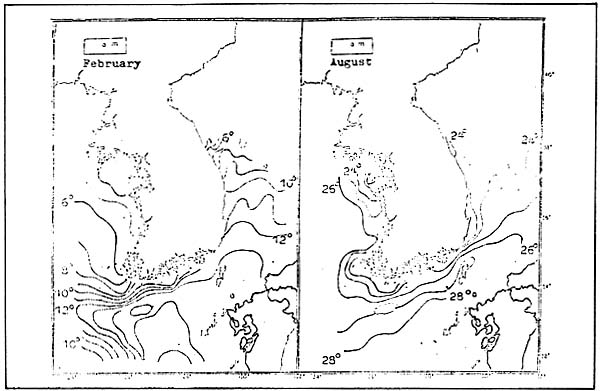
Figure 3. Mean seawater temperatures in the coastal waters of South Korea in February and August.
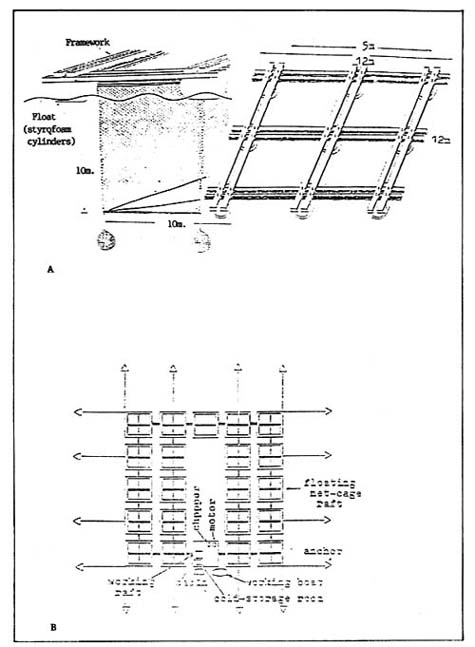
Figure 4. A) A 10m × 10m culture frame unit, and B) a typical netcage farm layout.
V. Culture Methods
The finfish culture period in Korea can be divided in three distinct phases. In spring the farmers collect the fingerlings with small fishing boat, or purchase the seeds from hatcheries. The growth of finfish is restricted to summer and autumn, and most fish disease problems occur during these seasons. In winter, the finfishes stocked in the netcage have to overcome the cold season.
- Seed collection and purchase
Yellowtail seeds are collected using round haul nets in May and July in the southern sea of Korea, during the migration under the seaweeds drifted by the Kuroshio. Seabream and seabass fry are usually caught using set nets in the spawning grounds, while seeds of the flat fish and rock fish are produced artificially.
- Points to be considered in seed stocking
Prevention of bacterial infection.
Size grading to prevent cannibalism.
Rapid acclimatization to new feeds.
Evaluation of the number, body weight and length.
- Feeding
Small and inexpensive fish like sardine, sand eel, and mackerel are usually fed. Feeding frequency depends on the species and size, however it is usually done twice a day, in the morning and afternoon. Feeding rate is determined following careful analysis of the weather, water temperature, tidal currents, amount of left over feed, etc.
- Stocking and replacement of nets
Although the stocking density is determined by the environmental conditions of the culture grounds, usually 7 to 10 kg of fish/m3 is empirically recommended. The nets should be replaced when they become clogged by fouling organisms to ensure high water exchange rates. In summer, replacement is usually done every ten days.
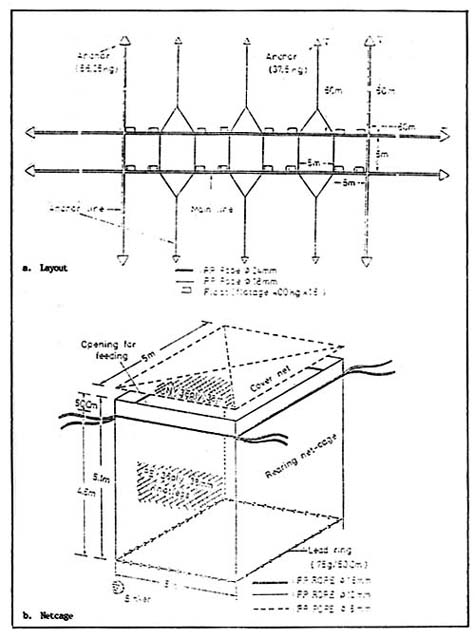
Figure 5. Layout of frameless floating netcages.
VI. Disease and Control
Up to 1983, fish cultured in floating netcages did not suffer from diseases
except for little losses due to parasites like Benedenis, Heteraxine and
Caligus. However at the moment losses due to diseases are increasing in
proportion to the expansion of the finfish culture production and number of
species cultured. Table 4 shows the state of fish disease occurrence.
In Korea, some infective microbial diseases often cause large damage to
cultured yellowtail. Up to now, they are Pasteurellosis, Streptococcosis
and Vibriosis which can be treated by ampicillin, erythromycin and
oxytetracycline, respectively.
However strong the treatment of diseased fish with antibacterial drugs,
many cases are beyond medical treatment, after full disease outbreak.
Therefore, farmers should take preventive measures before such outbreaks.
With the advance of knowledge on the immune mechanisms of fish, the
development of practical vaccines against microbial diseases is being
attempted.
Table 4. State of fish disease occurrence
| Species | Disease | No. of occurrence | Period | (Month) | |
| 1985 | 1986 | 1985 | 1986 | ||
| Yellowtail | Vibrio sp. | 2 | 3 | 6–7 | 7–10 |
| Pseudomonas sp. | 1 | 1 | 8 | 7, 9 | |
| Pasteurella piscicida | 1 | 7 | 8 | 9 | |
| Streptococcus sp. | 3 | 2 | 9 | 10 | |
| Heteraxine heterocerca | 1 | 7 | 7 | 7–9,12 | |
| Benedenia serialae | 1 | 6 | 9 | 8–9,12 | |
| Caligus spinosus | 1 | 6 | |||
| Seabream | Vibrio anguillarum | 1 | 6 | ||
| Pseudomonas sp. | 1 | 5 | |||
| Bivagina tai | 2 | 5, 8 | |||
| Seabass | Vibrio sp. | 1 | 10 | ||
| Pseudomonas sp. | 1 | 7 | |||
| Dactylogyrus sp. | 1 | 1 | 7 | 4 | |
| Rockfish | Lymphocystic disease | 1 | 7 | ||
| Microcotyle sp. | 1 | 7 | |||
VII. Harvesting and Handling Methods
The harvesting period of finfish cultured in floating netcages depend on
the species. Coastal species like seabass, rockfish, etc., are harvested
after they attain the marketable size. The period of culture is normally 2
or 3 years from stocking. On the other hand, the yellowtail, which is a
warm-water species, has to be harvested before winter.
Harvesting method is relatively simple. First, a netcage is selected and
fishes starved for about 2 days. The farmer then harvests the fish using
handnets, after reducing the space within the netcage by lifting it on
three sides. Fish are transported alive in well-aerated tanks.
VIII. Constraints
Major constraints of finfish aquaculture in Korea are:
lack of suitable sites,
difficulties of securing sufficient feed,
limited number of species suited for aquaculture, and
slow or no growth during the cold season.